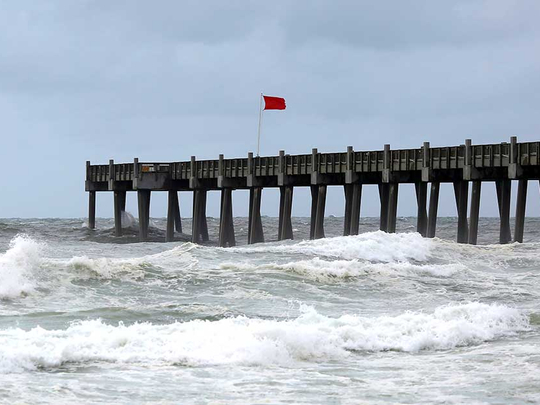
PANAMA CITY: Michael’s leading edge careened onto northwest Florida’s white-sand beaches as a still-growing Category 4 hurricane on Wednesday, lashing the coast with tropical storm-force winds and rain and pushing a storm surge that could cause catastrophic damage well inland once it makes landfall.
The unexpected brute quickly sprang from a weekend tropical depression with top winds growing to 145mph, the most powerful hurricane in recorded history for this stretch of the Florida coast.
The sheriff in Panama City’s Bay County issued a shelter-in-place order before dawn Wednesday, and Florida Gov. Rick Scott tweeted that for people in the hurricane’s path, “the time to evacuate has come and gone ... SEEK REFUGE IMMEDIATELY.”
At 8am, Michael’s eye was about 145km from Panama City and Apalachicola, moving relatively fast at 13mph (21kph). Tropical-storm force winds extended 185 miles (295 kilometres) from the centre, lashing the coast, and hurricane-force winds were coming closer, reaching 75km from the centre.
The storm appeared to be so powerful — with a central pressure dropping to 933 millibars — that it was expected to remain a hurricane as it moves over central Georgia early Thursday, and unleash damaging winds all the way into the Carolinas.
“We are in new territory,” National Hurricane Centre Meteorologist Dennis Feltgen wrote in a Facebook post Wednesday. “The historical record, going back to 1851, finds no Category 4 hurricane ever hitting the Florida panhandle.”
Rainfall could reach up to 30cm, and the life-threatening storm surge could swell to four metres.
Several hours ahead of landfall, seawater was already lapping over the docks at Massalina Bayou near downtown Panama City, and knee-deep water was rising up against buildings in St. Marks, which sits on an inlet south of Tallahassee. Many evacuees sought shelter in the capital city, which is about 25 miles from the coast and covered by live oak and pine trees, vulnerable to falling and causing power outages in even in smaller storms.
Florida officials said more than 375,000 people up and down the Gulf Coast had been urged or ordered to evacuate.
Only a skeleton staff remained at Tyndall Air Force Base, located on a peninsula just south of Panama City. The home to the 325th Fighter Wing and some 600 military families appeared squarely targeted for the worst of the storm’s fury, and leaders declared “HURCON 1” status, ordering out all but essential personnel. The base’s aircraft, which include F-22 Raptors, were flown hundreds of miles away as a precaution, a spokesman said.
Evacuations spanned 22 counties from the Florida Panhandle into north central Florida. But civilians don’t have to follow orders, and authorities feared many failed to heed their calls to get out of the way as the hard-charging storm intensified over 84-degree water in the Gulf of Mexico.
“I guess it’s the worst-case scenario. I don’t think anyone would have experienced this in the Panhandle,” said meteorologist Ryan Maue of weathermodels.com. “This is going to have structure-damaging winds along the coast and hurricane force winds inland.”
Maue and other meteorologists watched in real time as a new government satellite showed the hurricane’s eye tightening, surrounded by lightning that lit it up “like a Christmas tree.”
University of Georgia’s Marshall Shepherd, a former president of the American Meteorological Society, called it a “life-altering event,” writing on Facebook that he watched the storm’s growth on satellite images with a growing pit in his stomach.
Sheriff AJ Smith in Franklin County, near the vulnerable coast, sent his deputies door-to-door Tuesday urging people to evacuate, saying they did everything they could to get the word out.
Most of the waterfront homes stood vacant in Keaton Beach, which could get some of the highest water — seas up 2.75 metres above ground level.
“I know it’s going to cover everything around here,” said Robert Sadousky, who at 77 has stayed through more than four decades of storms.
The retired mill worker took a last look at the canal behind his home, built on tall stilts overlooking the Gulf. He pulled two small boat docks from the water, packed his pickup and picked some beans from his garden before getting out — like hundreds of thousands elsewhere.
The local geography — low-lying land and lots of areas where people live along waterways — means many people living inland could see their homes flooded as Michael makes landfall.
“We don’t know if it’s going to wipe out our house or not,” Jason McDonald, of Panama City, said as he and his wife drove north to safety into Alabama with their two children, ages five and seven. “We want to get them out of the way.”
Scott had warned of a “monstrous hurricane,” and his Democratic opponent for the Senate, Sen. Bill Nelson, described a destructive “wall of water,” but some officials didn’t see any rush of evacuees ahead of the storm.
“I am not seeing the level of traffic on the roadways that I would expect when we’ve called for the evacuation of 75 per cent of this county,” Bay County Sheriff Tommy Ford said Tuesday.












